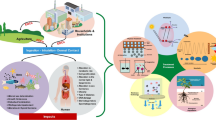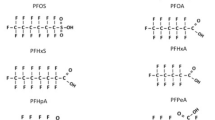Abstract
Both dioxins/dioxin-like compounds and polycyclic aromatic hydrocarbons (PAHs) are persistent organic pollutants and cause multiple adverse health effects on human and wildlife. Cyp1a is the most commonly used biomarker induced by these pollutants through activation of the aryl hydrocarbon receptor (AhR) pathway. Here we generated Tg(cyp1a:gfp) transgenic zebrafish for establishing a convenient in vivo assay for analysing these xenobiotic compounds. The Tg(cyp1a:gfp) larvae at 4 day post-fertilization were tested with 2,3,7,8-tetrachlorodibenzo-p-dioxin (TCDD), and GFP induction was observed mainly in the kidney, liver and gut. Similar GFP expression was also induced strongly by two dioxin-like chemicals, co-planar polychlorinated biphenyl (PCB126) and polychlorinated dibenzo-p-furan (PeCDF) and relatively weakly by two PAHs, 3-methylcholanthrene (3-MC) and benzo[a]pyrene (BAP). The lowest observed effective concentration (LOEC) of TCDD was estimated to be ∼1 pM and the EC50 (effective concentration to induce GFP in 50 % of Tg(cyp1a:gfp) larvae) was ∼10 pM. PCB126 and PeCDF had ∼10× lower potencies in GFP induction than TCDD, while the potencies for 3-MC and BAP were at least 1000× lower. The sensitivity of Tg(cyp1a:gfp) larvae to respond TCDD was also favourable compared to that of ethoxyresorufin-O-deethylase (EROD) assay in both zebrafish larvae and adult livers. As GFP-based assay in transgenic zebrafish can be easily accommodated in multi-well dishes, the Tg(cyp1a:gfp) zebrafish should provide not only a valuable biomonitoring tool for aquatic contaminants but also a potential high-throughput chemical screening platform for identification of new AhR agonists.






Similar content being viewed by others
References
Aqil F, Shen H, Jeyabalan J, Xin X, Lehmler HJ, Ludewig G, Robertson LW, Gupta RC (2014) Sustained expression of CYPs and DNA adduct accumulation with continuous exposure to PCB126 and PCB153 through a new delivery method: polymeric implants. Toxicol Rep 1:820–833. doi:10.1016/j.toxrep.2014.09.010
Billiard SM, Hahn ME, Franks DG, Peterson RE, Bols NC, Hodson PV (2002) Binding of polycyclic aromatic hydrocarbons (PAHs) to teleost aryl hydrocarbon receptors (AHRs). Comp Biochem Physiol B Biochem Mol Biol 133:55–68
Black MB, Budinsky RA, Dombkowski A, Cukovic D, Lecluyse EL, Ferguson SS, Thomas RS, Rowlands JC (2012) Cross-species comparisons of transcriptomic alterations in human and rat primary hepatocytes exposed to 2,3,7,8-tetrachlorodibenzo-p-dioxin. Toxicol Sci 127:199–215. doi:10.1093/toxsci/kfs069
Brack W, Schirmer K (2003) Effect-directed identification of oxygen and sulfur heterocycles as major polycyclic aromatic cytochrome P4501A-inducers in a contaminated sediment. Environ Sci Technol 37:3062–3070
Couillard CM, Legare B, Bernier A, Dionne Z (2011) Embryonic exposure to environmentally relevant concentrations of PCB126 affect prey capture ability of Fundulus heteroclitus larvae. Mar Environ Res 71:257–265. doi:10.1016/j.marenvres.2011.01.010
Emelyanov A, Gao Y, Naqvi NI, Parinov S (2006) Trans-kingdom transposition of the maize dissociation element. Genetics 174:1095–1104. doi:10.1534/genetics.106.061184
Gandhi N, Bhavsar SP, Reiner EJ, Chen T, Morse D, Arhonditsis GB, Drouillard KG (2015) Evaluation and interconversion of various indicator PCB schemes for summation operatorPCB and dioxin-like PCB toxic equivalent levels in fish. Environ Sci Technol 49:123–131. doi:10.1021/es503427r
Hestermann EV, Stegeman JJ, Hahn ME (2000) Relative contributions of affinity and intrinsic efficacy to aryl hydrocarbon receptor ligand potency. Toxicol Appl Pharmacol 168:160–172. doi:10.1006/taap.2000.9026
Humphrey CA, Codi King S, Klumpp DW (2007) A multibiomarker approach in barramundi (Lates calcarifer) to measure exposure to contaminants in estuaries of tropical North Queensland. Mar Pollut Bull 54:1569–1581. doi:10.1016/j.marpolbul.2007.06.004
Kanungo J, Lantz S, Paule MG (2011) In vivo imaging and quantitative analysis of changes in axon length using transgenic zebrafish embryos. Neurotoxicol Teratol 33:618–623. doi:10.1016/j.ntt.2011.08.013
Kim KH, Park HJ, Kim JH, Kim S, Williams DR, Kim MK, Jung YD, Teraoka H, Park HC, Choy HE, Shin BA, Choi SY (2013) Cyp1a reporter zebrafish reveals target tissues for dioxin. Aquat Toxicol 134–135:57–65. doi:10.1016/j.aquatox.2013.03.010
Kodavanti PR, Ward TR (2005) Differential effects of commercial polybrominated diphenyl ether and polychlorinated biphenyl mixtures on intracellular signaling in rat brain in vitro. Toxicol Sci 85:952–962. doi:10.1093/toxsci/kfi147
Lanham KA, Peterson RE, Heideman W (2012) Sensitivity to dioxin decreases as zebrafish mature. Toxicol Sci 127:360–370. doi:10.1093/toxsci/kfs103
Meyer J, Di Giulio R (2002) Patterns of heritability of decreased EROD activity and resistance to PCB 126-induced teratogenesis in laboratory-reared offspring of killifish (Fundulus heteroclitus) from a creosote-contaminated site in the Elizabeth River, VA, USA. Mar Environ Res 54:621–626
Ng GHB, Gong ZY (2011) Maize Ac/Ds transposon system leads to highly efficient germline transmission of transgenes in medaka (Oryzias latipes). Biochimie 93:1858–1864. doi:10.1016/j.biochi.2011.07.006
Ng GHB, Gong ZY (2013) GFP transgenic medaka (Oryzias latipes) under the inducible cyp1a promoter provide a sensitive and convenient biological indicator for the presence of TCDD and other persistent organic chemicals. Plos One 8:e64334. doi:10.1371/journal.pone.0064334
Otte JC, Schmidt AD, Hollert H, Braunbeck T (2010) Spatio-temporal development of CYP1 activity in early life-stages of zebrafish (Danio rerio). Aquat Toxicol 100:38–50. doi:10.1016/j.aquatox.2010.07.006
Pardo-Martin C, Chang TY, Koo BK, Gilleland CL, Wasserman SC, Yanik MF (2010) High-throughput in vivo vertebrate screening. Nat Methods 7:634–636. doi:10.1038/Nmeth.1481
Rappe C, Nygren M, Lindstrom G, Buser HR, Blaser O, Wuthrich C (1987) Polychlorinated dibenzofurans and dibenzo-p-dioxins and other chlorinated contaminants in cow milk from various locations in Switzerland. Environ Sci Technol 21:964–970. doi:10.1021/es50001a009
Ryu YM, Kim KN, Kim YR, Sohn SH, Seo SH, Lee SH, Kim HW, Won NH, Kim MK (2005) Gene expression profiles related with TCDD-induced hepatotoxicity. Mol Cell Toxicol 1:164–171
Safe SH (1994) Polychlorinated biphenyls (PCBs): environmental impact, biochemical and toxic responses, and implications for risk assessment. Crit Rev Toxicol 24:87–149. doi:10.3109/10408449409049308
Tartu S, Angelier F, Bustnes JO, Moe B, Hanssen SA, Herzke D, Gabrielsen GW, Verboven N, Verreault J, Labadie P, Budzinski H, Wingfield JC, Chastel O (2015) Polychlorinated biphenyl exposure and corticosterone levels in seven polar seabird species. Environ Pollut 197:173–180. doi:10.1016/j.envpol.2014.12.007
Tremoen NH, Fowler PA, Ropstad E, Verhaegen S, Krogenaes A (2014) Exposure to the three structurally different PCB congeners (PCB 118, 153, and 126) results in decreased protein expression and altered steroidogenesis in the human adrenocortical carcinoma cell line H295R. J Toxic Environ Health A 77:516–534. doi:10.1080/15287394.2014.886985
Truong L, Reif DM, St Mary L, Geier MC, Truong HD, Tanguay RL (2014) Multidimensional in vivo hazard assessment using zebrafish. Toxicol Sci 137:212–233. doi:10.1093/toxsci/kft235
Van Der Oost R, Beyer J, Vermeulen NP (2003) Fish bioaccumulation and biomarkers in environmental risk assessment: a review. Environ Toxicol Pharmacol 13:57–149
Vogt A, Cholewinski A, Shen X, Nelson SG, Lazo JS, Tsang M, Hukriede NA (2009) Automated image-based phenotypic analysis in zebrafish embryos. Dev Dyn 238:656–663. doi:10.1002/dvdy.21892
Wang BL, Pang ST, Sun JP, Zhang XL, Li XL, Sun YG, Lu XM, Zhang Q (2015) Levels of polychlorinated biphenyls in settled house dust from urban dwellings in China and their neurodevelopmental effects on preschool-aged children. Sci Total Environ 505:402–408. doi:10.1016/j.scitotenv.2014.10.026
Weber R, Gaus C, Tysklind M, Johnston P, Forter M, Hollert H, Heinisch E, Holoubek I, Lloyd-Smith M, Masunaga S, Moccarelli P, Santillo D, Seike N, Symons R, Torres JP, Verta M, Varbelow G, Vijgen J, Watson A, Costner P, Woelz J, Wycisk P, Zennegg M (2008) Dioxin- and POP-contaminated sites--contemporary and future relevance and challenges: overview on background, aims and scope of the series. Environ Sci Pollut Res Int 15:363–393. doi:10.1007/s11356-008-0024-1
Westerfield M (2007) The zebrafish book; a guide for the laboratory use of zebrafish (Danio rerio), 3rd edn. University of Oregon Press, Eugene
Whyte JJ, Jung RE, Schmitt CJ, Tillitt DE (2000) Ethoxyresorufin-O-deethylase (EROD) activity in fish as a biomarker of chemical exposure. Crit Rev Toxicol 30:347–570. doi:10.1080/10408440091159239
Wolz J, Engwall M, Maletz S, Olsman Takner H, Van Bavel B, Kammann U, Klempt M, Weber R, Braunbeck T, Hollert H (2008) Changes in toxicity and Ah receptor agonist activity of suspended particulate matter during flood events at the rivers Neckar and Rhine—a mass balance approach using in vitro methods and chemical analysis. Environ Sci Pollut Res Int 15:536–553. doi:10.1007/s11356-008-0056-6
Acknowledgments
This work was supported by the Singapore National Research Foundation under its Environmental and Water Technologies Strategic Research Programme and administered by the Environment and Water Industry Programme Office (EWI) of the PUB, grant number R-154-000-328-272, and National Medical ResearchCouncil of Singapore, grant number R-154-000-547-511.
Author information
Authors and Affiliations
Corresponding author
Additional information
Hongyan Xu and Caixia Li contributed equally to this work.
Rights and permissions
About this article
Cite this article
Xu, H., Li, C., Li, Y. et al. Generation of Tg(cyp1a:gfp) Transgenic Zebrafish for Development of a Convenient and Sensitive In Vivo Assay for Aryl Hydrocarbon Receptor Activity. Mar Biotechnol 17, 831–840 (2015). https://doi.org/10.1007/s10126-015-9669-1
Received:
Accepted:
Published:
Issue Date:
DOI: https://doi.org/10.1007/s10126-015-9669-1




